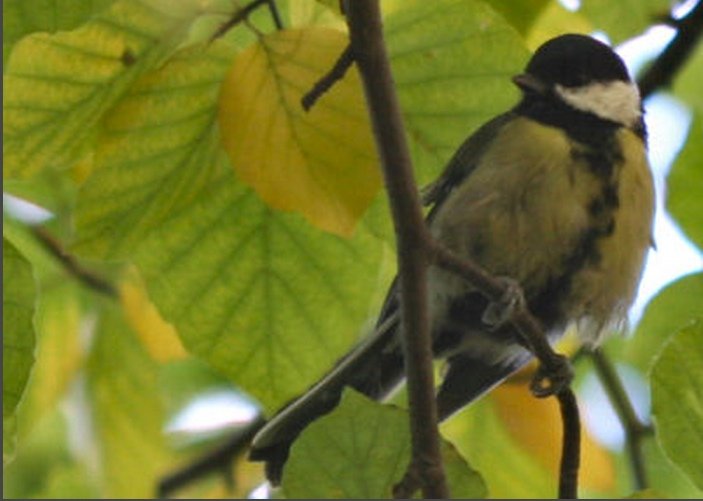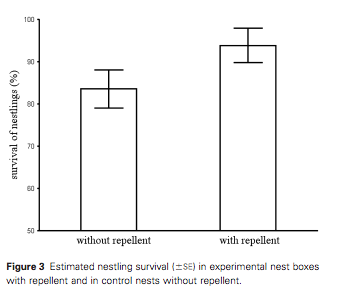
It is hard to think of too many downsides to birds, but there are some and here I’d like to mention one that we all know about but has been recently studied more closely. The results of this research paper appear in the Journal of Zoology.
You know that birds carry various parasites in their blood, and often, these parasites are transmitted to and from the birds via ticks or other ectoparasites. It is probably the case that the rapid spread of Lyme Disease from Connecticut to the rest of the United States and adjoining regions of Canada was because some species of birds (but not all) can carry Lyme disease, and can also carry the ticks that carry the disease.
Here’s the abstract from this recent paper:
Blood parasites are often considered as indicators of immunity in birds, and data on parasite prevalence and intensity of infections are essential to reveal information about the condition of both individuals and populations. We prevented parasite vectors from biting and infecting nestling great tit Parus major by using insect repellent inside nest boxes. We found that in the absence of blood parasites, great tit nestlings had higher concentrations of haemoglobin, and they survived at signi?cantly higher rates through the nestling phase and also during the ?rst weeks of their ?edgling period. This is the ?rst demonstration so far of the impact these parasites have on haemoglobin levels of the hosts, which reveals one mechanism of adverse impact by blood parasites. This study shows that the effects of blood parasites can be assessed without using anti-malaria drugs, which can cause additional risk of oxidative stress.
To me, this an interesting fact wrapped in language about a somewhat esoteric research program involving malaria and stuff. Here’s the part that I find interesting. When you get rid of the blood parasites, the nestlings survived at significantly higher rates. How much higher? This much higher:
A lot has been made of honest advertising of quality in birds and other animals. The idea is this: Add some ridiculous debilitating feature or carry out some absurd energy demanding behavior and see how you do. If it slows you down or wears you out, that could be because you are sick, or perhaps just by chance you somehow ended up at the short end of the gene pool. A potential mate will notice this and skip over you to find a different partner.
Birds are famous for their mating displays, rituals, coloration, vocalization, and so on and so forth. These are all things that demand physical stamina or otherwise well operating physiological systems, which are not likely to be the case if one is loaded up with too many parasites. Too many parasites also reduce reproductive output.
This is stuff we all already knew, or at least strongly suspected and occasionally saw evidence of. This study shows a huge difference in nestling survival with a change (albeit a significant change) in parasite load, and thus, is an excellent example of the importance of assessing parasite load or other health related issues for birds.
The paper is:
Krams, et al. 2013. Tackling Blood Parasites Helps Birds Survive Avian Malaria. Journal of Zoology. Link














Really interesting stuff, Greg — thanks! It also furthers my resolve to glove up when I’m handling injured/ill birds … can’t take any chances.
It is interesting to validate and quantify what is otherwise a logical assumption: increased parasite load, reduced health and reproductive success.
One thing missing though, is the point. How is this data proving useful? Is it a public service announcement to wear gloves during, and wash your hands after, handling birds?
I would argue against mass-treatment of bird populations for parasites, because who is to say that their lack of fitness is something that nature wants around? Survival of the fittest and all that, you know. Extinction happens, and sometimes it is for good reasons. Or better yet, eventually a nice mutation comes along that allows the species to resist the parasites. Parasites and disease are powerful evolutionary forces.
Cool stuff. Are those blood parasites thought to have just sneaked in through a random fold in evolution, or is there a reason why they be beneficial in small doses? Say, by somehow forcing the host to take it easy with the mating displays?
I don’t think the parasites are beneficial to the host (thus the name, “parasite”!). Blood parasites and ectoparasites are pretty much universal, and are just part of the ecology in which every organism lives. The interesting evolutionary story here is that many of the features we see in birds, especially many that we notice most readily, have probably evolved to address the parasite issue. Overall health of an individual (not a species) is a product of an effective immune system, effective foraging, good neurological function (i.e. good decisions about where to forage, nest, etc.) with a healthy dose of luck. There is a theory called the “Handicap principle” which suggests that those selecting mates will themselves be selected to be good at picking mates who are doing well in all these categories partly on the grounds that you can’t do well in these areas if you are not genetically “fit” …. along with being lucky, etc. etc. So, choosers are selected to be selective, and selectivity means focusing on and being able to identify *honest* indications of status/health etc.
So those additional features …. bright colors, absurdly long tails, loud and energy-demanding song, etc. … are honest indicators of status.
What this research demonstrates nicely is the link between parasite load and reproduction, which is only part of the bigger picture. This was something we already knew but it is nice to have a specific example from which to, say, make a nice power point slide to use in your lecture in biology class, or just to marvel at.